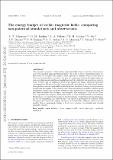Files in this item
The energy budget of stellar magnetic fields : comparing non-potential simulations and observations
Item metadata
| dc.contributor.author | Lehmann, L. T. | |
| dc.contributor.author | Jardine, M. M. | |
| dc.contributor.author | Vidotto, A. A. | |
| dc.contributor.author | Mackay, D. H. | |
| dc.contributor.author | See, Wyke Chun Victor | |
| dc.contributor.author | Donati, J. -F. | |
| dc.contributor.author | Folsom, C. P. | |
| dc.contributor.author | Jeffers, S. V. | |
| dc.contributor.author | Marsden, Steve | |
| dc.contributor.author | Morin, J. | |
| dc.contributor.author | Petit, P. | |
| dc.date.accessioned | 2016-10-31T17:30:33Z | |
| dc.date.available | 2016-10-31T17:30:33Z | |
| dc.date.issued | 2017-03-21 | |
| dc.identifier | 247264988 | |
| dc.identifier | 7c905d43-1b17-4771-a9a9-91d41d7318de | |
| dc.identifier | 85018344806 | |
| dc.identifier | 000410059100006 | |
| dc.identifier.citation | Lehmann , L T , Jardine , M M , Vidotto , A A , Mackay , D H , See , W C V , Donati , J -F , Folsom , C P , Jeffers , S V , Marsden , S , Morin , J & Petit , P 2017 , ' The energy budget of stellar magnetic fields : comparing non-potential simulations and observations ' , Monthly Notices of the Royal Astronomical Society: Letters , vol. 466 , no. 1 , pp. L24-L28 . https://doi.org/10.1093/mnrasl/slw225 | en |
| dc.identifier.issn | 1745-3925 | |
| dc.identifier.other | ArXiv: http://arxiv.org/abs/1610.08314v1 | |
| dc.identifier.other | ORCID: /0000-0001-6065-8531/work/133726085 | |
| dc.identifier.other | ORCID: /0000-0002-1466-5236/work/133734289 | |
| dc.identifier.uri | https://hdl.handle.net/10023/9742 | |
| dc.description | LTL acknowledges support from the Scottish Universities Physics Alliance (SUPA) prize studentship and the University of St Andrews Higgs studentship. MMJ and VS acknowledge a Science & Technology Facilities Council (STFC) postdoctoral fellowship. | en |
| dc.description.abstract | The magnetic geometry of the surface magnetic fields of more than 55 cool stars have now been mapped using spectropolarimetry. In order to better understand these observations, we compare the magnetic field topology at different surface scale sizes of observed and simulated cool stars. For ease of comparison between the high-resolution non-potential magnetofrictional simulations and the relatively low-resolution observations, we filter out the small-scale field in the simulations using a spherical harmonics decomposition. We show that the large-scale field topologies of the solar-based simulations produce values of poloidal/toroidal fields and fractions of energy in axisymmetric modes that are similar to the observations. These global non-potential evolution model simulations capture key magnetic features of the observed solar-like stars through the processes of surface flux transport and magnetic flux emergence. They do not, however, reproduce the magnetic field of M-dwarfs or stars with dominantly toroidal field. Furthermore, we analyse the magnetic field topologies of individual spherical harmonics for the simulations and discover that the dipole is predominately poloidal, while the quadrupole shows the highest fraction of toroidal fields. Magnetic field structures smaller than a quadrupole display a fixed ratio between the poloidal and toroidal magnetic energies. | |
| dc.format.extent | 2262314 | |
| dc.language.iso | eng | |
| dc.relation.ispartof | Monthly Notices of the Royal Astronomical Society: Letters | en |
| dc.subject | Stars: activity | en |
| dc.subject | Stars: magnetic field | en |
| dc.subject | Stars: solar-type | en |
| dc.subject | Methods: analytical | en |
| dc.subject | QB Astronomy | en |
| dc.subject | QC Physics | en |
| dc.subject | T-DAS | en |
| dc.subject.lcc | QB | en |
| dc.subject.lcc | QC | en |
| dc.title | The energy budget of stellar magnetic fields : comparing non-potential simulations and observations | en |
| dc.type | Journal article | en |
| dc.contributor.sponsor | Science & Technology Facilities Council | en |
| dc.contributor.institution | University of St Andrews. School of Physics and Astronomy | en |
| dc.contributor.institution | University of St Andrews. Applied Mathematics | en |
| dc.identifier.doi | https://doi.org/10.1093/mnrasl/slw225 | |
| dc.description.status | Peer reviewed | en |
| dc.identifier.url | https://arxiv.org/abs/1610.08314 | en |
| dc.identifier.grantnumber | ST/M001296/1 | en |
This item appears in the following Collection(s)
Items in the St Andrews Research Repository are protected by copyright, with all rights reserved, unless otherwise indicated.

